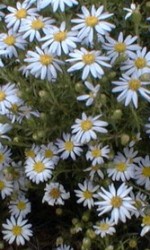 Stiff aster, also known by other names including bristle aster, flaxleaf whitetop, and savory leaf aster, is a clump-forming herbaceous perennial native to eastern and central US where it grows in disturbed sites such as fields, meadow, and grasslands as well as along waterways and in woodlands. It is a member of the Asteraceae family that also includes daisies, sunflowers, yarrow and lettuce. The plants are compact and have stiff unbranched stems that carry rough, stiff, linear ,almost needle-like leaves 1 to 1.5 inches long. The flowerheads appear in late summer to early fall in flat toped terminal clusters called corymbs. Each flowerhead is ¾ to 1 inch across and consists of white, purple or violet ray flowers surrounding a center of yellow disc flowers. The flowers are a nectar and pollen for bees and butterflies find while birds and mammals eat the seeds. An excellent choice for a wildflower or cutting garden The generic name Aster comes from the Latin word aster meaning star, referring to the form of the flowers. The specific epithet, liniarifolius comes from the Latin words linearis meaning linear and folius meaning leaf, referring to the needle-like form of the leaf.
Stiff aster, also known by other names including bristle aster, flaxleaf whitetop, and savory leaf aster, is a clump-forming herbaceous perennial native to eastern and central US where it grows in disturbed sites such as fields, meadow, and grasslands as well as along waterways and in woodlands. It is a member of the Asteraceae family that also includes daisies, sunflowers, yarrow and lettuce. The plants are compact and have stiff unbranched stems that carry rough, stiff, linear ,almost needle-like leaves 1 to 1.5 inches long. The flowerheads appear in late summer to early fall in flat toped terminal clusters called corymbs. Each flowerhead is ¾ to 1 inch across and consists of white, purple or violet ray flowers surrounding a center of yellow disc flowers. The flowers are a nectar and pollen for bees and butterflies find while birds and mammals eat the seeds. An excellent choice for a wildflower or cutting garden The generic name Aster comes from the Latin word aster meaning star, referring to the form of the flowers. The specific epithet, liniarifolius comes from the Latin words linearis meaning linear and folius meaning leaf, referring to the needle-like form of the leaf.
Type: Herbaceous perennial
Bloom: Terminal clusters of flowerheads ¾ to 1 inch across in late summer to early fall consisting of white, purple or violet ray flowers surrounding a center of yellow disc flowers.
Size: 1-2’ H x 1’ W
Light: Full sun to part shade
Soil: Average, dry tomoderately, well-drained, slightly acid
Hardiness: Zones 4-9
Care: Low maintenance
Pests and Diseases: None of significance
Propagation: Division
Companion Plants: Goldenrod, ornamental grasses, sedum ‘Autumn Joy’, blackeyed Susan, hyssop leaved bonset, hardy ageratum